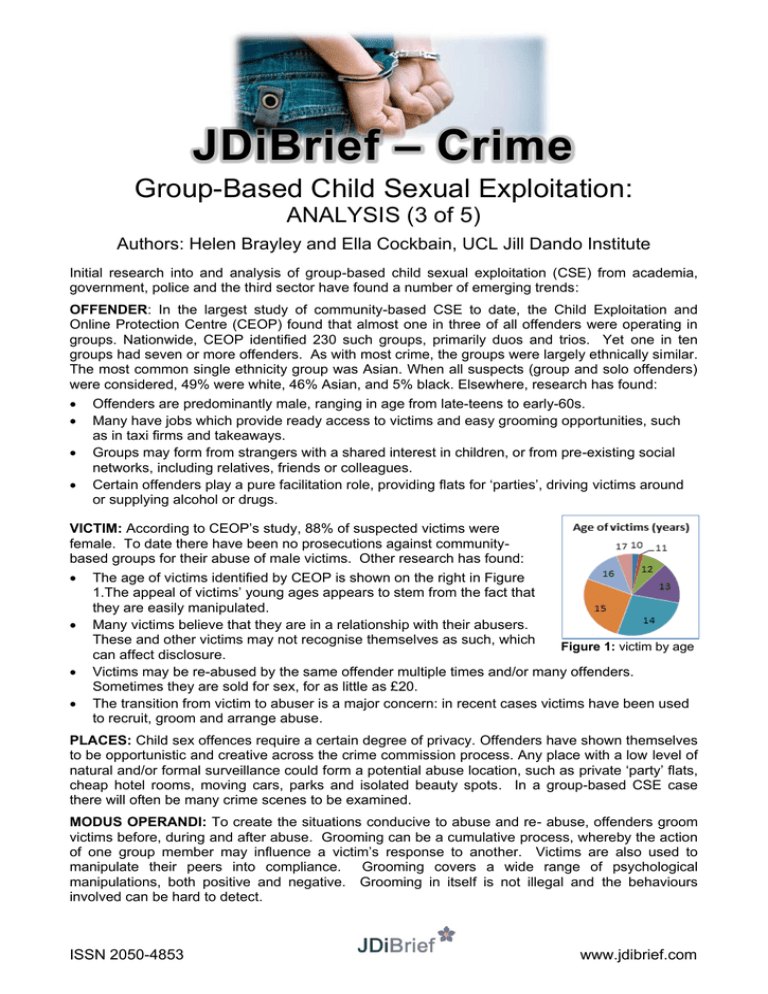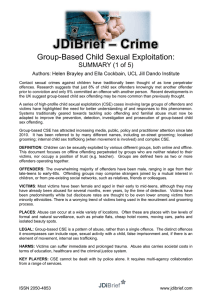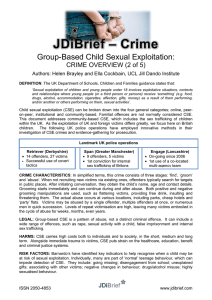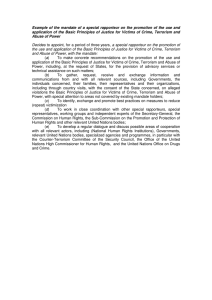
JDiBrief – Crime
Group-Based Child Sexual Exploitation:
ANALYSIS (3 of 5)
Authors: Helen Brayley and Ella Cockbain, UCL Jill Dando Institute
Initial research into and analysis of group-based child sexual exploitation (CSE) from academia,
government, police and the third sector have found a number of emerging trends:
OFFENDER: In the largest study of community-based CSE to date, the Child Exploitation and
Online Protection Centre (CEOP) found that almost one in three of all offenders were operating in
groups. Nationwide, CEOP identified 230 such groups, primarily duos and trios. Yet one in ten
groups had seven or more offenders. As with most crime, the groups were largely ethnically similar.
The most common single ethnicity group was Asian. When all suspects (group and solo offenders)
were considered, 49% were white, 46% Asian, and 5% black. Elsewhere, research has found:
Offenders are predominantly male, ranging in age from late-teens to early-60s.
Many have jobs which provide ready access to victims and easy grooming opportunities, such
as in taxi firms and takeaways.
Groups may form from strangers with a shared interest in children, or from pre-existing social
networks, including relatives, friends or colleagues.
Certain offenders play a pure facilitation role, providing flats for ‘parties’, driving victims around
or supplying alcohol or drugs.
VICTIM: According to CEOP’s study, 88% of suspected victims were
female. To date there have been no prosecutions against communitybased groups for their abuse of male victims. Other research has found:
The age of victims identified by CEOP is shown on the right in Figure
1.The appeal of victims’ young ages appears to stem from the fact that
they are easily manipulated.
Many victims believe that they are in a relationship with their abusers.
These and other victims may not recognise themselves as such, which
Figure 1: victim by age
can affect disclosure.
Victims may be re-abused by the same offender multiple times and/or many offenders.
Sometimes they are sold for sex, for as little as £20.
The transition from victim to abuser is a major concern: in recent cases victims have been used
to recruit, groom and arrange abuse.
PLACES: Child sex offences require a certain degree of privacy. Offenders have shown themselves
to be opportunistic and creative across the crime commission process. Any place with a low level of
natural and/or formal surveillance could form a potential abuse location, such as private ‘party’ flats,
cheap hotel rooms, moving cars, parks and isolated beauty spots. In a group-based CSE case
there will often be many crime scenes to be examined.
MODUS OPERANDI: To create the situations conducive to abuse and re- abuse, offenders groom
victims before, during and after abuse. Grooming can be a cumulative process, whereby the action
of one group member may influence a victim’s response to another. Victims are also used to
manipulate their peers into compliance. Grooming covers a wide range of psychological
manipulations, both positive and negative. Grooming in itself is not illegal and the behaviours
involved can be hard to detect.
ISSN 2050-4853
www.jdibrief.com






